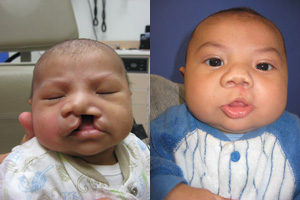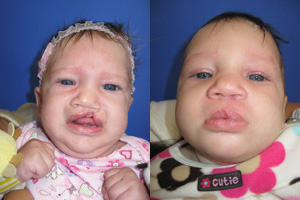Birth Defects Prevention Month: Cleft Lip and Palate

If the lip is open up to and including the floor of the nose (above left), it is called a complete cleft lip.
Parents dreaming of the arrival of a new bundle of joy hope for a healthy baby. Yet, many babies are born with birth defects. According to the March of Dimes, more than 120,000 babies in the U.S. are born each year with a birth defect.
Cleft lip and cleft palate occur in about 1 or 2 of every 1,000 American babies each year, making it one of the most common major birth defects, according to the Nemours Foundation.
Joshua Demke, M.D., Texas Tech Physicians Surgery, assistant professor of facial, plastic and reconstructive surgery, said clefts of the lip could occur with or without a cleft palate. Cleft lip and palate is more common in boys, and isolated cleft palate is more common in girls.
Development and Detection
"In utero an embryo develops rapidly,” Demke said. “Before four weeks gestation it is normal for the upper lip to be cleft. But by seven weeks the lip segments have fused in most embryos to form an intact upper lip. Only when this fusion fails does a cleft lip result."
Clefts of the lip can sometimes be detected in utero using advanced ultrasound technology, but clefts of the palate are rarely seen on ultrasound, Demke said. Knowing about a cleft lip and/or palate before a baby is born enables parents to meet with a cleft team to discuss what to expect, surgery and long-term management.
In most cases of cleft lip and/or cleft palate there are no other abnormalities or genetic problems, Demke said. It is believed that a combination of environmental triggers and underlying genetic factors contribute to clefts, but there are known syndromes associated with cleft lip and/or palate.
"A cleft palate can be a clue to look closely and rule out other abnormalities that might be involved such as heart problems,” Demke said. “A visit with a geneticist can be helpful to make a diagnosis and to help with family planning and understanding risks of inheritance that are not always straight-forward."

Demke said many parents worry when they first see their baby's cleft lip or palate, but they can typically be closed when the child is 2 to 3 months old.
Correction and Prevention
Demke said parents may feel discouraged when they first see their baby's cleft, but should remember cleft lip and cleft palate can be corrected. Cleft lip is typically closed surgically when a baby is 2 to 3 months old, Demke said. Palatoplasty, or surgically closing off and separating the roof of the mouth from the nose, is typically performed when a baby is 9 to 12 months old.
"Operating too early leads to problems with growth restriction of the upper face, and waiting too long can lead to bad speech habits that can be challenging or impossible to overcome,” Demke said. "Children with cleft lip and palate frequently face problems with hearing loss and usually require one or more sets of temporary tubes to help with their ears."
Babies with craniofacial deformities may also have problems with feeding and weight gain, Demke said. Large clefts of the palate can make it difficult for babies to breastfeed because they can’t generate suction, and as a result may require special bottles and nipples.
Uncorrected clefts in young children can result in missing teeth, crowding and cross bites. A bone graft is frequently needed at 7 to 9 years old to stabilize the bone of the front teeth. Braces and palatal expanders are commonly needed to help with crowding and cross bites.
Because neonatal surgery is risky, Demke said his advice to expectant mothers is to do everything they can to prevent birth defects in the first place. He said pregnant women can reduce their babies’ risk of cleft lip and palate by being aware of risk factors including smoking, diabetes, seizure medications, exposure to pesticides, lack of folic acid and alcohol and drug use.
Related Stories
Celebrating Veterans: TTUHSC’s General Martin Clay’s Legacy of Service and Leadership
From his initial enlistment in the Army National Guard 36 years ago to his leadership in military and civilian health care management roles, Major General Martin Clay’s career has been shaped by adaptability, mission focus and service to others.
Texas Tech University Health Sciences Center School of Nursing Named Best Accelerated Bachelor of Science in Nursing Program in Texas
The TTUHSC School of Nursing Accelerated Bachelor of Science in Nursing (BSN) program has been ranked the No. 1 accelerated nursing program in Texas by RegisteredNursing.org.
TTUHSC Names New Regional Dean for the School of Nursing
Louise Rice, DNP, RN, has been named regional dean of the TTUHSC School of Nursing on the Amarillo campus.
Recent Stories
Making Mental Health a Priority in the New Year
Sarah Mallard Wakefield, M.D., a psychiatrist with Texas Tech Physicians, talks about strategies to combat widespread and growing anxiety.
TTUHSC Cancer Researcher Honored by National Academy of Inventors
C. Patrick Reynolds, M.D., Ph.D., director of the School of Medicine Pediatric Cancer Research Center at TTUHSC, has dedicated his life as a researcher to developing treatments for childhood cancers.
TTUHSC School of Nursing Celebrates 10 Years of the Veteran to BSN Program
The TTUHSC School of Nursing recognized the 10-year anniversary of the Veteran to Bachelor of Science in Nursing (VBSN) program during the fall 2025 commencement ceremonies held Dec. 13 in Lubbock, Texas.
